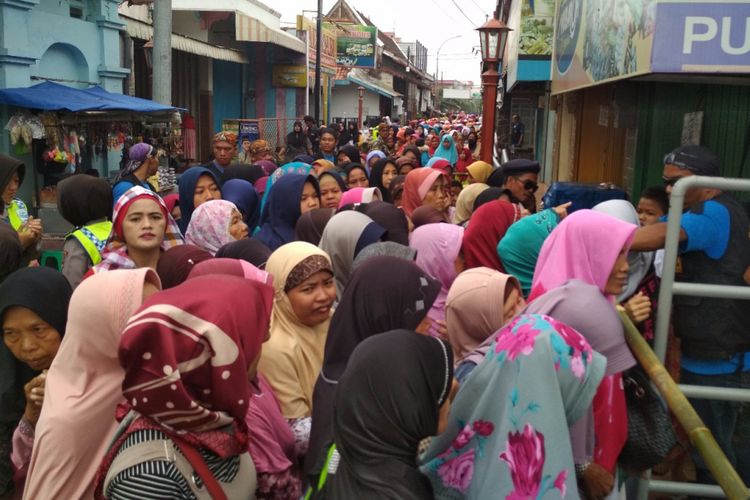Thousands of people eagerly compete for "Nasi Uyah Asem" provided during the Buka Luwur (Kelambu) tradition at the Tomb of Sunan Kudus, in the Menara Kudus Mosque complex, Central Java, on Thursday (September 20, 2018). Nasi Uyah Asem itself is rice with meat cooked in uyah asem seasoning wrapped in jati leaves.
This unique dish is still favored by people from various regions in the country. They are willing to wait in long queues to obtain this blessed rice. The queues are quite long and tiring as they take turns in the tradition held on the 10th of Muharram.
To avoid excessively long queues, the Buka Luwur committee divided them into two separate lines, one for women and one for men. The committee also displayed signboards indicating the queue routes.
Based on observations, a number of people appeared enthusiastic while enjoying the nasi uyah asem. Some individuals even save the dish to mix it with animal feed in the hope of protecting their livestock from diseases.
Sri Atmini (36), a resident of Mojokerto, East Java, admitted to intentionally traveling a long distance to Kudus to participate in the Buka Luwur tradition of Sunan Kudus to seek blessings. Besides having the opportunity to visit the Tomb of Sunan Kudus, she believes that consuming nasi uyah asem can bring blessings. "I have participated in the Buka Luwur ritual of Sunan Kudus three times, and Alhamdulillah, my sustenance has been smooth," said Atmini. Meanwhile, Slamet Prayitno (38), a resident of Sambung Village, Undaan District, Kudus, brings home blessed rice from the Buka Luwur tradition to use as feed for his poultry. "I have been eagerly awaiting this tradition," he said.
M. Nadjib Hassan, the Chairman of the Menara Mosque and Tomb of Sunan Kudus Foundation, explained that the blessed rice distributed to the general public amounted to 29,032 packages. The blessed rice consists of rice and meat cooked with uyah asem seasoning, wrapped in jati leaves and tied with agel string.
In addition to the blessed rice for the public, 2,498 blessed baskets were also distributed to invited guests. Both the blessed rice and baskets were prepared from 11 buffaloes and 84 goats.
The distributed meat and rice were sourced from the community's contributions. In addition to receiving financial assistance, the committee also received donations in the form of rice, buffaloes, goats, and spices. They received a total of 11 buffaloes and 84 goats as donations, while the cooked rice amounted to 6,760 kilograms out of the total donated rice of 12,126 kilograms.
As for the need for mori fabric replacement, which has been installed at the Tomb of Sunan Kudus for the past year, a total of 15,032 meters of mori fabric and 110 meters of curtains were made and installed.
Buka Luwur is a grand ritual that involved 1,175 perewang (assistants) and 10,095 members of the community who provided assistance in this year's Buka Luwur. M. Nadjib Hassan emphasized that this special ritual is called Buka Luwur, not Kaul as is common elsewhere because, until now, the exact date of Sunan Kudus' passing has not been found.
The main significance of conducting Buka Luwur, he stated, is to emulate the character and struggle of Sunan Kudus, who spread Islam through peaceful means and developed local culture. "In addition, Buka Luwur also serves as a reflection to preserve the legacy of Sunan Kudus, especially the teachings of tolerance that are much needed by society," he concluded.
This event was attended by hundreds of special guests, including scholars, community leaders, government institutions, and representatives of the Association of Guardians of Saints' Tombs (PPMA) from all over Java. Among the scholars present were KH. Syaroni Achmadi, KH. M. Ulil Albab Arwani, KH. Arifin Fanani, KH. Hasan Fauzi, KH. Noor Halim, Habib Umar al-Muthahar, and several other scholars from Kudus and surrounding areas. The Buka Luwur ceremony involved the recitation of the Yaumul Asyuro prayer led by KH. Syaroni Achmadi, followed by the installation of luwur ranjam on the tomb of Sunan Kudus, and concluded with a tahlil.






0 Comments